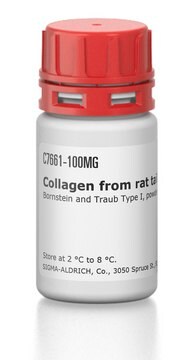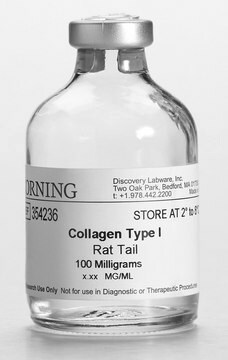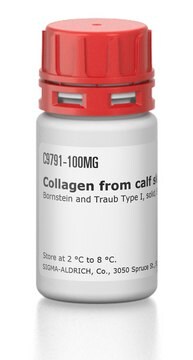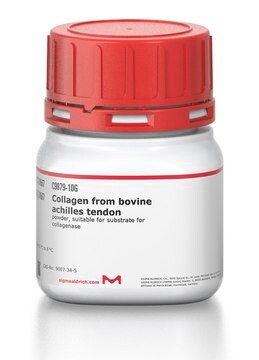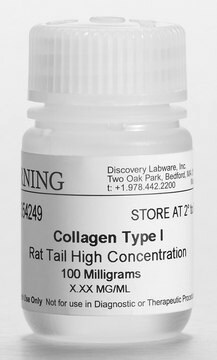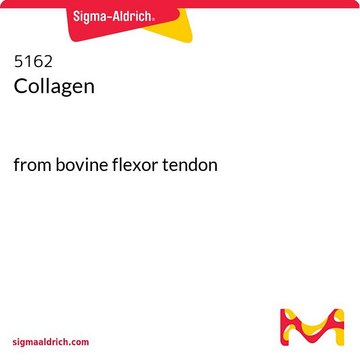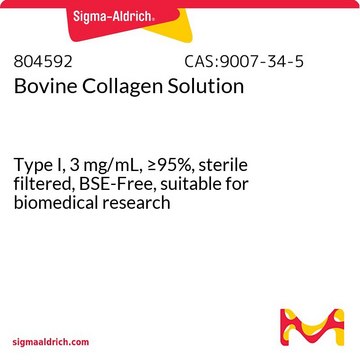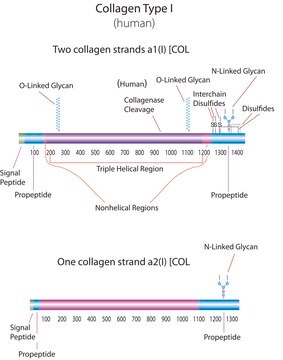C3867
Rat Collagen Type I
from rat tail, liquid, 4 mg/mL, suitable for cell culture
Synonym(s):
Collagen from rat tail, Col1a1
About This Item
Recommended Products
product name
Collagen, Type I solution from rat tail, BioReagent, suitable for cell culture, sterile-filtered
biological source
rat tail
Quality Level
description
Approx. 100mg/vial ((35 - 40 ml) )
sterility
sterile-filtered
product line
BioReagent
assay
>95% (SDS-PAGE)
form
liquid
mol wt
apparent mol wt 115-130 kDa by SDS-PAGE (doublet)
apparent mol wt 215-235 kDa by SDS-PAGE (doublet)
packaging
pkg of 1 vial
concentration
>0.5 mg/mL Biuret
technique(s)
cell culture | mammalian: suitable
surface coverage
6‑10 μg/cm2
impurities
Mycoplasma Test by Barile, none detected
solubility
soluble, clear to hazy, colorless (solubilized in 0.02M acetic acid)
NCBI accession no.
UniProt accession no.
binding specificity
Peptide Source: Collagen
Peptide Source: Fibronectin
shipped in
wet ice
storage temp.
2-8°C
Gene Information
rat ... Col1a1(29393)
Looking for similar products? Visit Product Comparison Guide
General description
Application
Biochem/physiol Actions
Features and Benefits
- Sourced from rat tail.
- Sterile-filtered to minimize contamination risks.
- Suitable for a wide range of cell culture applications.
- Provides optimal surface coverage (6-10 μg/cm2) for promoting cell adhesion and proliferation.
Preparation Note
SDS polyacrylamide gel electrophoresis analysis shows the typical band pattern for Type I collagen, with a doublet at apparent molecular weights of 115 and 130kDa and another doublet at 215 and 235kDa. Based on this analysis, the purity of the collagen sample is >95%.
Other Notes
Related product
Storage Class
10 - Combustible liquids
wgk_germany
WGK 1
flash_point_f
Not applicable
flash_point_c
Not applicable
Certificates of Analysis (COA)
Search for Certificates of Analysis (COA) by entering the products Lot/Batch Number. Lot and Batch Numbers can be found on a product’s label following the words ‘Lot’ or ‘Batch’.
Already Own This Product?
Find documentation for the products that you have recently purchased in the Document Library.
Customers Also Viewed
Articles
Attachment Factors for 3-Dimensional Cell Culture
The extracellular matrix (ECM) is secreted by cells and surrounds them in tissues.
Extracellular matrix proteins such as laminin, collagen, and fibronectin can be used as cell attachment substrates in cell culture.
Our team of scientists has experience in all areas of research including Life Science, Material Science, Chemical Synthesis, Chromatography, Analytical and many others.
Contact Technical Service